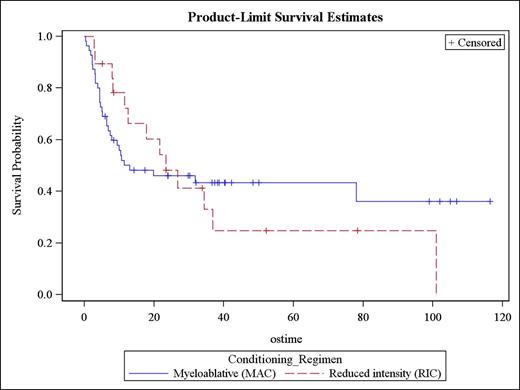Abstract

Introduction
Reduced intensity conditioning (RIC) regimens for allogeneic hematopoietic stem cell transplantation (SCT) offer a potential treatment for otherwise incurable cases of acute myelogenous leukemia (AML) with less associated toxicity compared to myeloablative conditioning (MAC). Eradication of malignant cells after RIC depends largely on the graft-versus leukemia effect (GVL). These regimens are becoming increasingly popular, particularly in older patients or those with comorbidities. They may also be offered to otherwise healthy patients based on personal or physician preference, as there is growing evidence that overall survival may be equivalent for both treatments. We retrospectively reviewed the charts of Saskatoon Cancer Centre patients receiving either RIC or MAC to compare the incidence and grade of graft versus host disease (GVHD), progression free survival (PFS), and overall survival (OS).
Methods
We identified 74 patients who underwent HSCT for AML in complete remission (CR) between January 2000- December 2013. Of these patients, 55 received MAC and 19 received RIC.
Median age at HSCT was 48 years (range 18-68). In the group receiving MAC, 36% of patients were >50 years, whereas 74% of patients receiving RIC were >50 yrs of age.
Results
Patients receiving RIC experienced greater incidence of chronic GVHD (63% vs 41%, p=.09) and relapse (54% vs 30%, p=.07). Incidence of acute GVHD was the same for either regimen (53%).
Median overall survival was similar (39 vs 38 months), with lower early mortality in RIC later overtaking MAC at 27 months. Progression free survival demonstrated a non-statistically significant advantage for MAC (median 43 vs 49 months).
Conclusion
RIC has been associated with greater incidence of chronic GVHD and relapse, with no difference in overall survival. Patients receiving RIC are more likely to be >50 years of age, making comparisons challenging. The results of this review suggest that MAC is the preferred regimen for patients who can tolerate its toxic effects due to reduced incidence of chronic GVHD and relapse, however the similarity in overall survival makes the choice of either conditioning regimen reasonable. Future studies to identify the best conditioning regimen are warranted.
Overall Survival
Progression Free Survival
No relevant conflicts of interest to declare.
Author notes
Asterisk with author names denotes non-ASH members.

This icon denotes a clinically relevant abstract



This feature is available to Subscribers Only
Sign In or Create an Account Close Modal